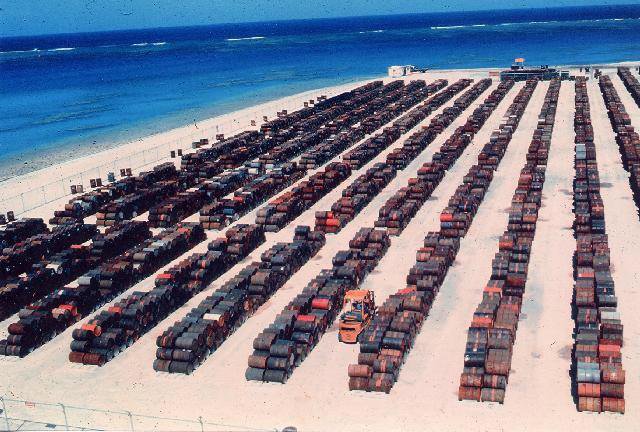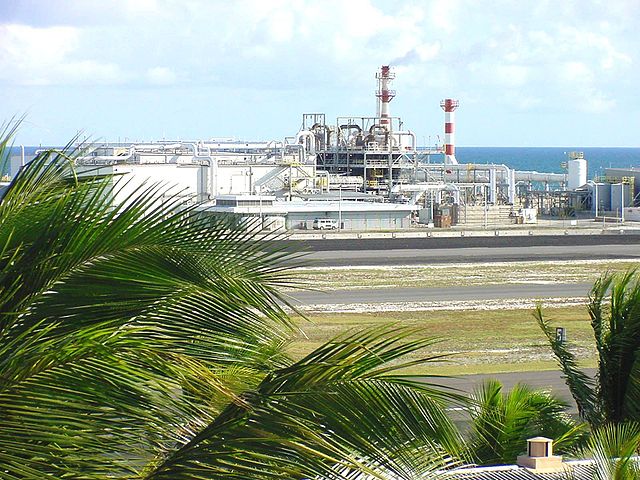

Bemerkungen: 1936-1964 Expansion der Johnston-Insel von 0,19 auf 2,41 km², Sand-Insel von 0,04 auf 0,09 km² und Aufschüttung zweier neuer Inseln: Akua (North Island) 0,10 km² und Hikina (East Island) 0,07 km² (Karte s. Fläche)[1] – 1958 und 1962 Abschussrampe und Testgebiet für 12 Atombomben (s. Atombombentests in der Nähe der Johnston-Insel) – 1971-2000 Johnston-Insel Lagerstätte für chemische Kampfstoffe, u. a. von Okinanwa[2] – 1990-2000 Verbrennungsanlage für chemische Kampfstoffe (Johnston Atoll Chemical Agent Disposal System/JACADS) auf der Johnston-Insel, u. a. aus Deutschland und den Salomonen[3] – 2004 Dekontamination und Säuberung[4] – 2006 schwere Zerstörungen durch Hurrikan Ioke[5] – 2010 Schätzung der Abrissarbeiten aller Gebäude und Installationen auf 590,3 Mio. US-Dollar[6] – 2010 Befall von 0,5 km² der Johnston-Insel durch die invasive Gelbe Spinnerameise [yellow crazy ants (YCA)/Anoplolepis gracilipes] und Bedrohung von nistenden Seevögeln, 2010-2021 Bekämpfung dieser Ameisenart durch so genannte „Bekämpfungsteams“ [Crazy Ant Strike Teams (CAST)[7] – wird mit der Baker-Insel, Howland-Insel, Jarvis-Insel, Kingman-Riff, Palmyra Atoll und Wake Atoll als „entlegene Pazifische Inseln“ [Pacific Remote Island Areas (PRIAS)] zusammengefasst[8]
[1] Welcome to Johnston Atoll National Wildlife Refuge, U. S. Fish and Wildlife Service (USFWS), Department of the Interior (DOI) 2011-04-05, http://www.fws.gov/johnstonisland/ (aufgerufen am 2013-05-06)
[2] Timeline JACADS, U. S. Army Chemical Materials Agency (CMA) o. J., http://www.cma.army.mil/fndocumentviewer.aspx?DocID=003673801 (aufgerufen am 2013-05-14)
[3] Timeline JACADS, U. S. Army Chemical Materials Agency (CMA) o. J., http://www.cma.army.mil/fndocumentviewer.aspx?DocID=003673801 (aufgerufen am 2013-05-14)
[4] Resource Management, Johnston Atoll National Wildlife Refuge, U. S. Fish and Wildlife Service (USFWS), U. S. Department of the Interior (DOI) 2013-02-28, http://www.fws.gov/refuge/Johnston_Atoll/what_we_do/resource_management.html (aufgerufen am 2014-06-04) und Official Record, Johnston Island National Wildlife Refuge, protectedplanet.net o. J., http://www.protectedplanet.net/sites/Johnston_Island_National_Wildlife_Refuge (aufgerufen am 2014-06-04)
[5] Impacts, Hurricane Ioke 20-27 August 2006, 2006 Tropical Cyclones Central North Pacific, Central Pacific Hurricane Center (CPHC), National Weather Service Juli 2007, http://www.prh.noaa.gov/cphc/summaries/2006.php#ioke (aufgerufen am 2013-05-14)
[6] Johnston Atoll (S. 150), Base Structure Report Fiscal Year 2010 Baseline (A Summary of DoD’s Real Property Inventory), Office of the Deputy Under Secretary of Defense (Installations and Environment), Department of Defense (DOD) 2009-09-30, http://www.acq.osd.mil/ie/download/bsr/bsr2010baseline.pdf (aufgerufen am 2013-05-13)
[7] Resource Management, What We Do, Johnston Atoll National Wildlife Refuge, U. S. Fish & Wildlife Service (USFWS), U. S. Department of the Interior (DOI) 2015-07-07, https://www.fws.gov/refuge/Johnston_Atoll/what_we_do/resource_management.html (aufgerufen am 2021-04-08) und 7-Month Biological Volunteers, Biological Volunteers Needed, Get Involved, What We Do, Johnston Atoll National Wildlife Refuge, U. S. Fish & Wildlife Service (USFWS), U. S. Department of the Interior (DOI) 2020-02-27, https://www.fws.gov/refuge/Johnston_Atoll/what_we_do/get_involved/CAST.html (aufgerufen am 2021-04-08)
[8] U. S. Pacific Remote Island Areas (PRIAS), Coral Reef Information System (CoRIS), National Oceanic and Atmospheric Administration (NOAA), U. S. Department of Commerce (DOC) 2012-08-22, http://coris.noaa.gov/portals/pria.html (aufgerufen am 2013-05-14)
Bildquelle/n:
- Bild: leckende Agent Orange-Fässer auf der Johnston-Insel ca. 1973: U. S. Government
- Bild: JACADS-Verbrennungsanlage für chemische Kampfstoffe auf der Johnston-Insel vor 2002: U.S. Army Chemical Materials Agency | Public Domain Mark 1.0
Neueste Kommentare